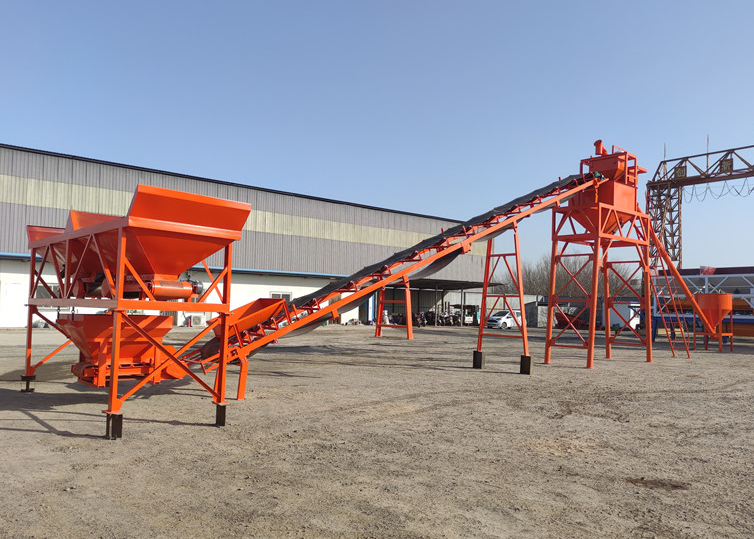Difference Between Dry and Wet Batch Concrete Plant
What Is a Dry Batch Concrete Plant?
A dry batch concrete plant combines aggregate materials such as sand, gravel, and cement in precise measurements. The mixture is discharged into a mixer truck, combined with a measured amount of water, and mixed in the truck on the way to the site.
Types of Concrete with Different Production Procedures
There are primarily two types of concrete batching plants, each with four combinations that operate with distinct production procedures:
1. Dry Batch Concrete Plant
2. Wet Batch Concrete Plant
3. Half-Wet Batch Concrete Plant
4. Combination Batch Concrete Plant
Choosing a suitable concrete batching plant is crucial, considering the construction characteristics and transportation facilities. The difference between dry mixed concrete plants and wet mixed concrete plants extends beyond the wet or dry mixture; there are other significant distinctions to consider.
It's essential to assess the specific requirements of the construction project to determine the most appropriate type of concrete batching plant for optimal performance. Dry concrete batch plant is a special plant used to mix concrete with compared to the other batching plants. The dry mixed concrete plant has higher efficiency, but it must work with the mixer truck to mix the concrete.
Difference Between Dry and Wet Batch Concrete Plant
Both them are used to produce concrete, but wet concrete plant can produce concrete on its own, because it has twin shaft paddle mixer as the mixing console. However, dry mix concrete batching plant needs to cooperate with concrete mixer truck, only this can it produce concrete for construction project.
Dry mix concrete batching plants, also referred to as dry batch concrete plants or dry mix batching plants, are facilities designed for the production of concrete by combining aggregate materials such as sand, gravel, and cement in precise measurements. In a dry batch plant, these raw materials are fed into the batching plant through numerical or manual scales and then discharged into a chute leading directly into a mixer truck. Water is added separately into the truck's charging tank, ensuring that all components are mixed en route to the construction site. Dry batch concrete plants have several advantages: they offer higher capacity with lower energy consumption, increase productivity by collaborating efficiently with mixer trucks, and allow for prompt use of the fresh mixture upon arrival at the site. The mixing system in a dry batch plant blends materials without water, making the transportation and mixing process in the mixer truck crucial. These plants are highly favored in modern production, significantly contributing to infrastructure projects like roads and bridges.
In contrast, wet batch concrete plants, including wet batching plants and wet stationary concrete plants, utilize a central mixer to blend all components, including water, at a central location before dispatching the ready-mix concrete to the construction site. Wet batch plants ensure the mixture remains stirred during transit using agitators or pre-mixed trucks to prevent premature setting. Compared to dry batch concrete plants, wet stationary plants can provide a more systematic mixing process, which may result in less variation in the breaking strength from load to load. Some facilities integrate characteristics of both dry and wet setups to enhance their versatility and application range. While dry batch concrete plants excel in efficiency and cost-effectiveness, wet batch concrete plants focus on delivering consistent quality concrete mixes suitable for various construction requirements.
Dry Batch Concrete Plant:
Also known as dry mix concrete plants, these facilities have sand, gravel, and cement feeding into the batching plant through numerical or manual scales. The raw materials are then discharged into a chute that leads into the truck. Simultaneously, water is either weighed or metered by volume and discharged into the mixer truck through the same charging tank. Finally, all the materials are mixed and transported to the site.
Wet Batch Concrete Plant:
Wet batch plants use a central mixer to blend all the components, including water, at a central location. The mixture is stirred while on its way to the site to prevent premature setting, often using agitators or pre-mixed trucks.
Similar to both mobile and stationary plants, dry batch concrete plants consist of cement silos, feeding systems, control systems, weighing systems, and mixing systems. Cement silos store and supply raw materials like cement, sand, and fly ash as production demands. The feeding system acts as a bridge connecting the aggregates and the mixing system. The accuracy of the weighing system determines the quantity of mixed materials, thereby significantly impacting the quality of the mixture. The mixing system blends the materials without water, making the mixer truck crucial for transporting and mixing. The control system serves as the core of the entire plant, offering full automation capabilities from the control room.
Dry mixing equipment differs from wet mixing equipment. While wet mix facilities utilize a central mixer, dry mix plants can provide a more consistent mixture in a shorter period. Dry batching plants may exhibit more variations in standard deviation of breaking strength and changes from load to load compared to wet mix plants, as the mixing of cement, stone, and other components can be less systematic. Some plants combine characteristics of both dry and wet mix setups to enhance versatility and application.
Advantages of Dry Concrete Batching Plants
- It has higher capacity and lower energy consumption because it can be mixed without water.
- The collaboration between the dry batching plant and the mixer truck can increase productivity and save time.
- The fresh mixture can be used promptly as the mixer trucks arrive at the construction site.
- It shortens the construction timeline and enhances overall productivity.
- It has lower power consumption compared to wet mix plants.
- Operating costs of dry-batch plants are relatively low.
- Allows concrete to be mixed more efficiently.
- It requires a shorter maintenance period compared to wet mix plants.
- Similar to other mixing plants, such as mobile and stationary plants, the dry batching plant is also automated.
- If the construction site is extensive, it is an ideal choice for concrete manufacturers. While the mixer truck is en route to the construction site, it can maintain the rotation order to prevent tampering and hardening of the mixed concrete, ensuring the freshness of the materials.
- Dry batch plants are highly welcomed modern production equipment that significantly contributes to the development and construction of modern roads, bridges, and various construction projects.
















